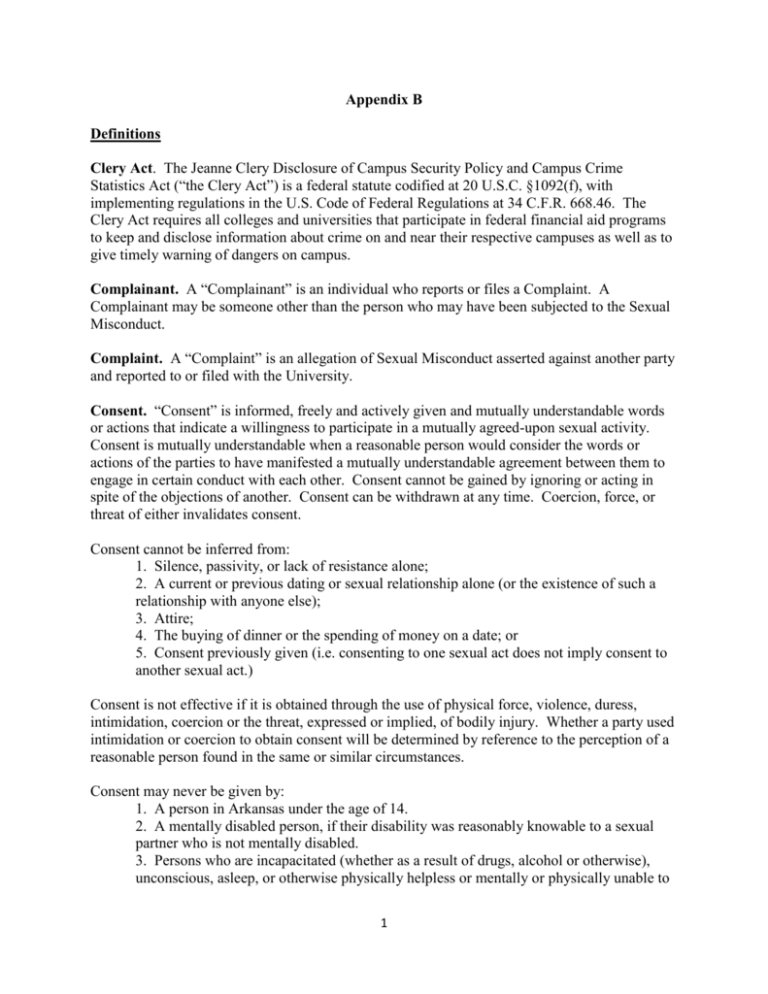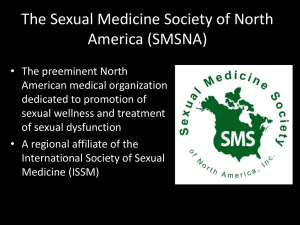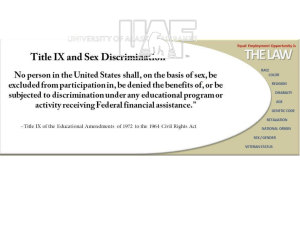
Appendix B
Definitions
Clery Act. The Jeanne Clery Disclosure of Campus Security Policy and Campus Crime
Statistics Act (“the Clery Act”) is a federal statute codified at 20 U.S.C. §1092(f), with
implementing regulations in the U.S. Code of Federal Regulations at 34 C.F.R. 668.46. The
Clery Act requires all colleges and universities that participate in federal financial aid programs
to keep and disclose information about crime on and near their respective campuses as well as to
give timely warning of dangers on campus.
Complainant. A “Complainant” is an individual who reports or files a Complaint. A
Complainant may be someone other than the person who may have been subjected to the Sexual
Misconduct.
Complaint. A “Complaint” is an allegation of Sexual Misconduct asserted against another party
and reported to or filed with the University.
Consent. “Consent” is informed, freely and actively given and mutually understandable words
or actions that indicate a willingness to participate in a mutually agreed-upon sexual activity.
Consent is mutually understandable when a reasonable person would consider the words or
actions of the parties to have manifested a mutually understandable agreement between them to
engage in certain conduct with each other. Consent cannot be gained by ignoring or acting in
spite of the objections of another. Consent can be withdrawn at any time. Coercion, force, or
threat of either invalidates consent.
Consent cannot be inferred from:
1. Silence, passivity, or lack of resistance alone;
2. A current or previous dating or sexual relationship alone (or the existence of such a
relationship with anyone else);
3. Attire;
4. The buying of dinner or the spending of money on a date; or
5. Consent previously given (i.e. consenting to one sexual act does not imply consent to
another sexual act.)
Consent is not effective if it is obtained through the use of physical force, violence, duress,
intimidation, coercion or the threat, expressed or implied, of bodily injury. Whether a party used
intimidation or coercion to obtain consent will be determined by reference to the perception of a
reasonable person found in the same or similar circumstances.
Consent may never be given by:
1. A person in Arkansas under the age of 14.
2. A mentally disabled person, if their disability was reasonably knowable to a sexual
partner who is not mentally disabled.
3. Persons who are incapacitated (whether as a result of drugs, alcohol or otherwise),
unconscious, asleep, or otherwise physically helpless or mentally or physically unable to
1
make informed, rational judgments. The use of alcohol or drugs does not excuse conduct
that constitutes Sexual Misconduct under this Policy.
Dating Violence. “Dating Violence” means violence committed by a person:
1. Who is or has been in a social relationship of a romantic or intimate nature with the
victim; and
2. Where the existence of such a relationship shall be determined based on a
consideration of the following factors:
a. The length of the relationship,
b. The type of relationship, and
c. The frequency of interaction between the persons involved in the relationship.
Domestic Violence. “Domestic Violence” includes felony or misdemeanor crimes of violence
committed by a current or former spouse of the victim, by a person with whom the victim shares
a child in common, by a person who is cohabitating with or has cohabitated with the victim as a
spouse or intimate partner, by a person similarly situated to a spouse of the victim under the
domestic or family violence laws of the State of Arkansas, or by any other person against an
adult or youth victim who is protected from that person’s acts under the domestic or family
violence laws of the State of Arkansas.
FERPA. The Family Educational Rights and Privacy Act (“FERPA”) is a federal statute
codified at 20 U.S.C. §1232g, with implementing regulations at 34 CFR Part 99. FERPA
protects the privacy of student education records. FERPA grants to parents or eligible students
the right to access, inspect, and review education records, the right to challenge the content of
education records, and the right to consent to the disclosure of education records.
Rape. “Rape” is the act of sexual intercourse or penetration (anal, oral or vaginal), however
slight, with any body part or any object, by a man or a woman upon a man or a woman, without
Consent, including vaginal penetration by a penis, object, tongue, or finger; anal penetration by a
penis, object, tongue or finger; and oral copulation (mouth to genital contact or genital to mouth
contact).
Respondent. A “Respondent” is an individual who has been accused of committing Sexual
Misconduct by the report or filing of a formal or informal Complaint.
Retaliation. “Retaliation” means any adverse action threatened or taken against a person
because he or she has filed, supported, or provided information in connection with a Complaint
of Sexual Misconduct, including, but not limited to direct and indirect intimidation, threats, and
harassment.
Sexual Assault. “ Sexual Assault” means any actual, attempted, or threatened sexual act with
another person without that person’s Consent. Sexual Assault includes, but is not limited to:
1. Rape and attempted Rape;
2. Intentional and unwelcome sexual touching (including disrobing or exposure),
however slight, with any body part or any object, by a man or a woman upon a man or a
2
woman, with effective Consent, or a person’s breasts, buttocks, groin, or genitals (or
clothing covering such areas), or coercing, forcing, or attempting to coerce or force
another to touch you, themselves, or a third party with any of these body parts or areas
when such touching would be reasonably and objectively offensive.
3. Any sexual act in which there is force, violence, or use of duress or deception upon
the victim;
4. Any sexual act perpetrated when the victim is unable to give Consent; and
5. Sexual intimidation, which includes, but is not limited to:
a. Threatening, expressly or impliedly, to commit a sexual act upon another
person without his or her Consent,
b. Stalking or cyber-stalking, and
c. Engaging in indecent exposure.
Sexual Exploitation. “Sexual Exploitation” means any act of taking non-Consensual, unjust or
abusive sexual advantage of another person for one’s own advantage or benefit or to benefit or
advantage anyone other than the person being exploited. Sexual Exploitation includes, but is not
limited to:
1. Causing or attempting to cause the incapacitation of another person in order to gain a
sexual advantage over such person;
2. Prostituting another person (i.e. personally gaining money, privilege or power from
the sexual activities of another);
3. Non-Consensual videotaping, photographing, or audio-taping of sexual activity and/or
distribution of these materials via media such as, but not limited to, the Internet;
4. Exceeding the boundaries of Consent (e.g., allowing another person to observe
Consensual sex without the knowledge of or Consent from all participants);
5. Voyeurism; and
6. Knowingly or recklessly transmitting a sexually transmitted disease (including HIV)
to another individual.
Sexual Harassment. “Sexual Harassment” is defined as unwelcome conduct that is severe and
pervasive, which substantially interferes with the learning, working, or living environment, and
which would detrimentally affect a reasonable person under the circumstances. Harassment is
extreme, outrageous or persistent acts or communications that are intended or reasonably likely
to harass, intimidate or humiliate another. Whether the alleged conduct constitutes prohibited
3
harassment depends on the entire circumstances, including the nature, frequency, type and
duration of the conduct. Examples of sexual harassment may include, but are not limited to, the
following:
i.
Verbal abuse of a sexual nature, which is considered to include, but is not limited to,
epithets, derogatory comments, sexual advances, invitations, propositions, comments, or
requests for sexual favors;
ii.
Intimate unwelcome physical contact;
iii.
Repeated unwanted discussions of sexual matters;
iv.
Use of sexual jokes, stories, analogies, or images which are not related to the subject of
the class or work situation;
v.
Ogling, leering, or prolonged staring at another person’s body;
vi.
Display or use of sexual graffiti or sexually-explicit pictures or objects;
vii.
Sexually suggestive jokes, comments, e-mails, or other written or oral communications;
viii.
Condition, explicitly or implicitly, academic or employment decisions upon an
individual’s submission to requests for sexual favors or conduct.
Sexual harassment by any faculty, staff or student is a violation of both federal regulatory law
and University policy and will not be tolerated at Tech. The University considers sexual
harassment to be a very serious issue and shall subject the offender to dismissal or other
sanctions following the University’s investigation and substantiation of the complaint and
compliance with due process requirements.
The determination of what constitutes sexual harassment will vary with the particular
circumstances, but it may be generally described as repeated and unwanted sexual behavior, such
as physical contact and verbal comments or suggestions that adversely affect the working or
learning environments of others.
EEOC Guidelines define sexual harassment as unwelcome sexual advances, request for sexual
favors, and other verbal or physical conduct of a sexual nature when:
a.
b.
Submission to such conduct is either explicitly or implicitly made a condition of
an individual’s employment with the University or a factor in the educational
program of a student, and/or;
Submission to or a rejection of such conduct by an individual is used as the basis
for an employment or academic decision affecting such individuals, and/or;
4
c.
Such conduct has the purpose or effect of substantially interfering with an
individual’s right to achieve an educational objective or to work in an
environment free of intimidation, hostility, or threats stemming from acts or
language of a sexual nature.
Although sexual harassment most frequently occurs when there is an authority differential
between the persons involved (faculty member and student, supervisor and staff member), it may
also occur between persons of the same status (e.g. faculty-faculty, staff-staff, student-student).
Both men and women may be victims of sexual harassment, and sexual harassment may occur
between individuals of the same gender.
Because of the unique situations which exist between students, faculty, supervisors, and staff,
relationships in the workplace and on campus should at all times remain professional. In
particular, due to the professional power differential between faculty and students, faculty
members are encouraged to remain professional in all relationships with students. As teachers,
professors encourage the free pursuit of learning by their students. They hold before them the
best scholarly standards of their discipline. Professors demonstrate respect for students as
individuals and adhere to their proper roles as intellectual guides and counselors. Professors
make every reasonable effort to foster honest academic conduct and to assure that their
evaluations of students reflect each student’s true merit. They respect the confidential nature of
the relationship between professor and student. They avoid any exploitation, harassment, or
discriminatory treatment of students. They acknowledge significant academic or scholarly
assistance from them. They protect their academic freedom.
Sexual harassment may create a hostile, abusive, demeaning, offensive, or intimidating
environment. It is manifested by verbal or physical actions, including gestures and other
symbolic conduct. Sexual harassment is not always obvious and overt; it can also be subtle and
covert. A person who is subject to sexual advances may nevertheless be a victim of sexual
harassment if those advances were unwelcome.
If a professor’s speech or conduct takes place in the teaching context, it must also be persistent,
pervasive, and not germane to the subject matter. The academic setting is distinct from the
workplace in that wide latitude is required for professional judgment in determining the
appropriate content and presentation of academic material.
Sexual Misconduct. “Sexual Misconduct” means any unwelcome conduct of a sexual nature,
including any conduct or act of a sexual nature perpetrated against an individual without
Consent. Sexual Misconduct can occur between strangers or acquaintances, including people
involved in an intimate or sexual relationship. Sexual Misconduct can be committed by men or
by women, and it can occur between people of the same or different sex. The University
encourages reporting of all Sexual Misconduct. Sexual Misconduct includes, but is not limited
to:
1.
Dating violence;
2.
Domestic violence;
5
3.
Non-forcible sex acts, which are unlawful sexual acts where Consent is not
relevant, such as sexual contact with an individual under the statutory age of
Consent, as defined by State law, or between persons who are related to each
other within degrees wherein marriage is prohibited by law.
4.
Sexual Assault;
5.
Sexual Exploitation;
6.
Sexual Harassment; and
7.
Stalking.
Stalking. “Stalking” means engaging in a course of conduct directed at a specific person that
would cause a reasonable person to:
1. fear for his or her safety or the safety of others; or
2. Suffer substantial emotional distress.
Student. A “student” is any student who is registered at the University or enrolled at the
University (a) at the time of the alleged Sexual Misconduct and (b) at the time a Complaint is
filed.
6









